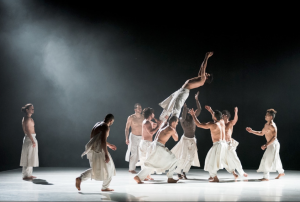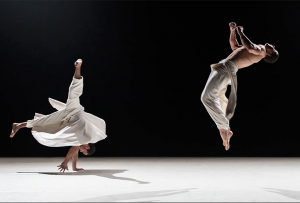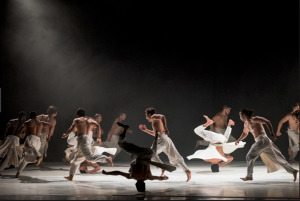Acrobatic, Ravishing Dance from Compagnie Hervé Koubi at UCSD

Photo: Cherylynn Tsushima
Hervé Koubi got his dance training in the city of his birth, Cannes, and began his career with the Opera de Marseille. His first choreographic work, The Golem (2000), drew on an Eastern European Jewish legend.
It was a typical start for a French dance artist. Then, at the age of 25, Koubi (now 41) learned that his family wasn’t French but native Algerian, he said in a talk before his company’s performance (the group’s San Diego debut) at UCSD ArtPower on Wednesday.
The revelation sparked a personal and artistic journey that led to his forming Compagnie Hervé Koubi, made up of 12 male dancers primarily from North Africa, most of whom began as street dancers. And it took his work into explorations of his Algerian-French identity including “What the day owes to the night,” the propulsive, gorgeous, sacred piece he presented here.
“What the day owes to the night” borrows its title from a novel by Algerian author Yasmina Khadra, but Koubi doesn’t tell the story; he was simply drawn to the poetry of the phrase. And, throughout the evening-length piece, he interweaves elements of supposedly separate realms.
 There’s a global palette of movement, from Middle Eastern Sufi dance to Brazilian capoeira to hip-hop, skillfully blended, so for instance the dancers do Sufi spinning not only standing but also, in dramatic B-boy style, on their hands and heads. Big capoeira leaps turn into corkscrew spins in the air.
There’s a global palette of movement, from Middle Eastern Sufi dance to Brazilian capoeira to hip-hop, skillfully blended, so for instance the dancers do Sufi spinning not only standing but also, in dramatic B-boy style, on their hands and heads. Big capoeira leaps turn into corkscrew spins in the air.
To these international and street forms, Koubi brings the stunning theatricality of European theatrical dance. Beautifully paced, “What the day owes to the night” has moments when the score goes silent, and the dancers simply stand facing the rear of the stage, as if in a private space. Then there are outbreaks of pandemonium: Three dancers spin on their heads as the rest break into a run. All 12 launch themselves into midair spins in an acrobatic, miraculously collision-free whirl.
 At times, two or three or all of the dancers come together—in a thrilling bit, they lift one man above their heads and catch him as he topples over. But even when they’re moving independently, there’s a sense of connection.
At times, two or three or all of the dancers come together—in a thrilling bit, they lift one man above their heads and catch him as he topples over. But even when they’re moving independently, there’s a sense of connection.
Like the dance styles, Koubi’s music choices cross cultural boundaries. Much of the music is from the East-West collaboration between Egyptian virtuoso Hamza El Din and the Kronos Quartet (their “Pieces of Africa” album). The entrancing sound score also includes Sufi music and excerpts from Bach’s Passion.
The dancers are dressed (by costumer Guillaume Gabriel) in skirted white pants reminiscent of Sufi garb, their muscular chests bare. And all of the lights, designed by Lionel Buzonie, are onstage and above; in one iteration, individual beams of light bathe the community dancers. It all feels like praying.
Sadly, this show played one night only. But you have two more chances to see great dance this weekend. This evening, the legendary Paul Taylor Company performs at the Spreckels Theatre (presented by La Jolla Music Society). Tonight and tomorrow afternoon, you can catch Jean Isaacs San Diego Dance Theater at the Saville Theatre; they’re performing work by Isaacs, Trystan Loucado, and Kyle Sorensen and Gina Bolles Sorensen.

Award-winning dance journalist Janice Steinberg has published more than 400 articles in the San Diego Union-Tribune, Dance Magazine, the Los Angeles Times, and elsewhere. She was a 2004 New York Times-National Endowment for the Arts fellow at the Institute for Dance Criticism and has taught dance criticism at San Diego State University. She is also a novelist, author of The Tin Horse (Random House, 2013). For why she’s passionate about dance, see this article on her web site, The Tin Horse
